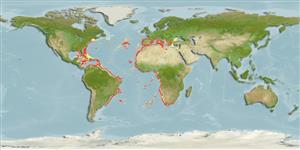Malacostraca |
Decapoda |
Pandalidae
Environment: milieu / climate zone / depth range / distribution range
Ecology
Benthic; depth range 190 - 1550 m (Ref. 106425), usually 500 - 750 m (Ref. 106425). Subtropical; 45°N - 38°S, 89°W - 34°E
Atlantic Ocean and the Mediterranean: From Portugal to South Africa (West African waters from 16° to 28°S) and Straits of Florida to Turkey.
Length at first maturity / Size / Weight / Age
Maturity: Lm ? range ? - ? cm Max length : 8.5 cm TL male/unsexed; (Ref. 804)
Found on the middle continental slope (Ref. 105377). Non-migrator macrozooplankton feeder (Ref. 52384). Active predator of macroplankton species. Diet is based on smaller prey like siphonophores, hyperiids and euphausiids (Ref. 105341).
Life cycle and mating behavior
Maturity | Reproduction | Spawning | Eggs | Fecundity | Larvae
Members of the order Decapoda are mostly gonochoric. Mating behavior: Precopulatory courtship ritual is common (through olfactory and tactile cues); usually indirect sperm transfer.
Bianchi, G., K.E. Carpenter, J.-P. Roux, F.J. Molloy, D. Boyer and H.J. Boyer 1999 FAO species identification guide for fishery purposes. Field guide to the living marine resources of Namibia. Rome, FAO. 265 p., 11 plates. (Ref. 804)
IUCN Red List Status
(Ref. 130435: Version 2025-1)
CITES status (Ref. 108899)
Not Evaluated
Not Evaluated
Threat to humans
Human uses
| FishSource |
Tools
More information
Life cycleReproductionMaturityFecunditySpawningEggsEgg developmentLarvae PhysiologyOxygen consumption
Human RelatedStamps, coins, misc.
Internet sources
Estimates based on models
Preferred temperature
(Ref.
115969): 5.9 - 14.3, mean 13.5 (based on 76 cells).
Resilience
High, minimum population doubling time less than 15 months (K=0.5-0.55).
Fishing Vulnerability
Low vulnerability (24 of 100).
